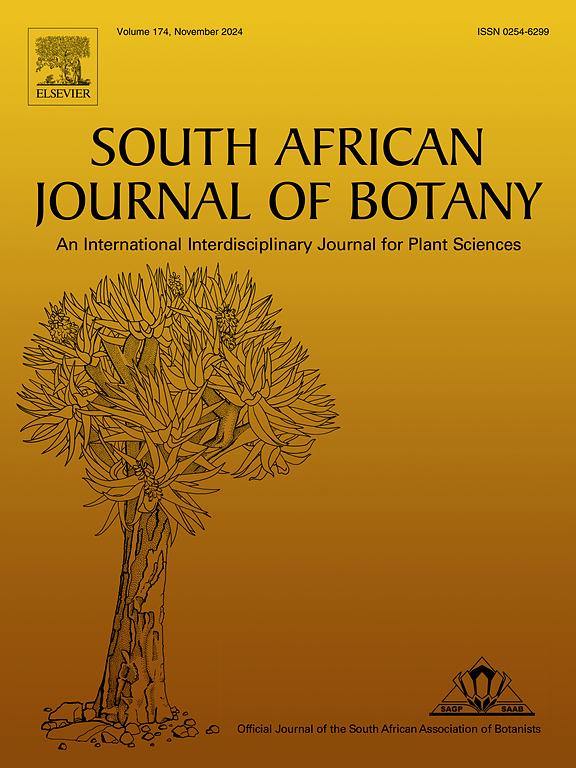Lichen morphospecies diversity and community composition across the Tswalu Kalahari Reserve, South Africa
IF 2.7
3区 生物学
Q2 PLANT SCIENCES
引用次数: 0
Abstract
The Tswalu Kalahari Reserve in the Northern Cape Province of South Africa has no previously published data on its lichen biota, which reflects the broader status of lichenology in South Africa. It is estimated that nearly half of the country's lichen species remain undescribed. Consequently, this study aimed to gather baseline data on lichen diversity and distribution across the reserve. We quantified morphological and functional diversity, characterized lichen communities, and analyzed relationships between lichen diversity and environmental variables (northness, coverage, elevation, insolation, site, substrate type, and substrate texture) using morphospecies concepts. We documented 49 morphospecies across three habitats in the Tswalu Kalahari Reserve, including at least one species that is new to science (Caloplaca tswaluensis Fryday, S. Svoboda & D. A. Ward; Fryday et al. in press) and another (Trapeliopsis glaucolepidea (Nyl.) Gotth. Schneid.) that had not previously been reported from Africa. Overall, we recorded lower diversity in corticolous (bark dwelling) lichen communities compared to saxicolous (rock dwelling) lichen communities. However, we did not find a significant effect of any measured environmental variable on saxicolous species richness. This preliminary study underscores the need for further investigation of the diverse, unrecorded lichen diversity that likely exists in other areas of the country as well as the differences in lichen communities on bark and rock substrates. This study also shows that morphospecies concepts can be informative and accessible approaches for exploratory lichen studies, particularly in regions with relatively understudied cryptogam communities.
南非特斯瓦卢卡拉哈里保护区地衣形态物种多样性和群落组成
南非北开普省的茨瓦卢卡拉哈里保护区以前没有发表过关于其地衣生物群的数据,这反映了南非地衣学的广泛现状。据估计,南非近一半的地衣物种仍未被描述。因此,本研究旨在收集保护区内地衣多样性和分布的基线数据。我们对地衣的形态和功能多样性进行了量化,描述了地衣群落的特征,并使用形态物种概念分析了地衣多样性与环境变量(北度、覆盖率、海拔、日照、地点、基质类型和基质质地)之间的关系。我们在茨瓦卢卡拉哈里保护区的三个栖息地记录了 49 个形态物种,其中至少有一个物种是科学界的新物种(Caloplaca tswaluensis Fryday, S. Svoboda & D. A. Ward; Fryday 等人,出版中),另一个物种(Trapeliopsis glaucolepidea (Nyl.) Gotth.Schneid.),以前从未在非洲报道过。总体而言,我们在皮质(树皮栖息)地衣群落中记录到的多样性低于沙质(岩石栖息)地衣群落。不过,我们没有发现任何环境变量对轴叶地衣物种丰富度的显著影响。这项初步研究强调了进一步调查该国其他地区可能存在的未记录的地衣多样性以及树皮和岩石基质上的地衣群落差异的必要性。这项研究还表明,形态种概念可以为地衣探索性研究提供信息和方法,尤其是在隐花植物群落研究相对不足的地区。
本文章由计算机程序翻译,如有差异,请以英文原文为准。
求助全文
约1分钟内获得全文
求助全文
来源期刊

South African Journal of Botany
生物-植物科学
CiteScore
5.20
自引率
9.70%
发文量
709
审稿时长
61 days
期刊介绍:
The South African Journal of Botany publishes original papers that deal with the classification, biodiversity, morphology, physiology, molecular biology, ecology, biotechnology, ethnobotany and other botanically related aspects of species that are of importance to southern Africa. Manuscripts dealing with significant new findings on other species of the world and general botanical principles will also be considered and are encouraged.
 求助内容:
求助内容: 应助结果提醒方式:
应助结果提醒方式:


